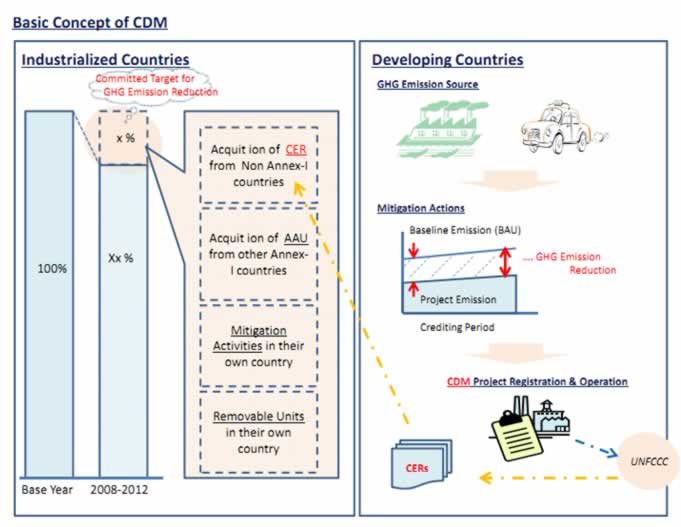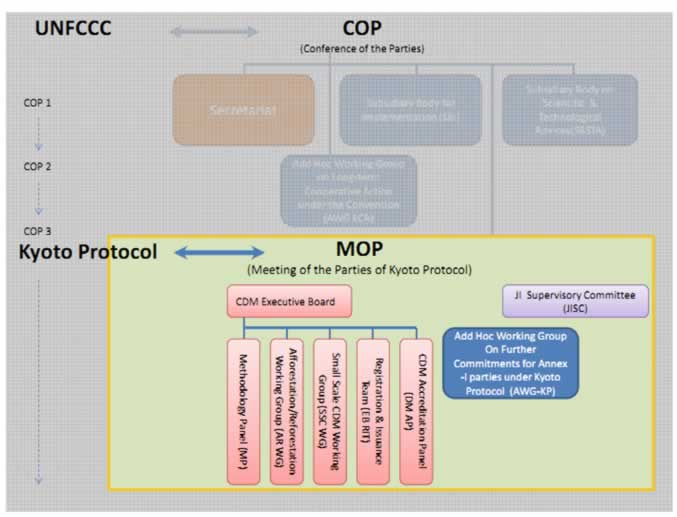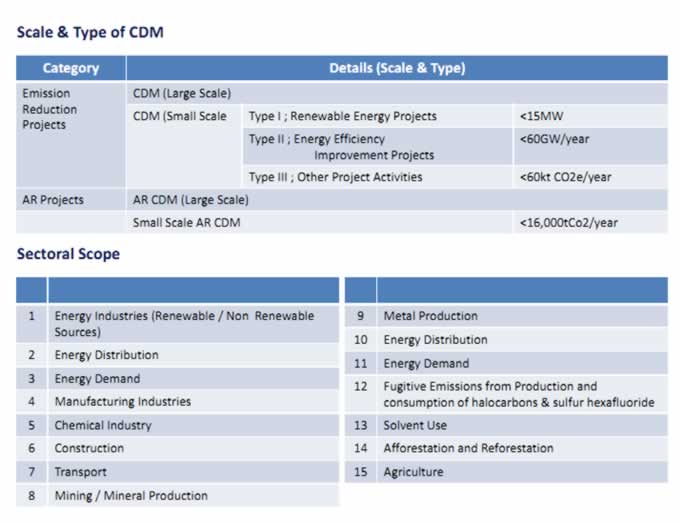Clean Development Mechanism
Clean Development Mechanisms or so called CDM is the one among the three flexibility mechanisms, is defined by Article 12 in Kyoto Protocol under United Nation Frameworks Convention on Climate Change (UNFCCC) with purposes of assisting Annex I parties to archive their committed amount of emission reduction in cost effective ways and on the other hand, contribution for sustainable development of Non Annex I parties .
Description in the Kyoto Protocol
In the Article 12, CDM is defined as; CDM Activities shall be hosted by Non Annex I parties which ratified the Kyoto Protocol, validated byDesignated Operational Entity (hereinafter referred as “DOE”) and registered by CDM Executive Board (hereinafter referred as “EB”)after review by a Registration and Institution Board.
 1. Keyword
1. Keyword
CER (Certified Emission Reduction)
Once any CDM project(s) registered under UNFCCC and completed verificationconducted by DOE, The EB issue Certified Emission Reduction (CER) for quantified emission reduction from the project(s). Unit of CER is 1Co2t and all CER are numbered. CER is tradable among the Annex I Partiesand public & private entities be authorized by the Annex I Parties and can be used to meet with their committed legally binding emission reduction quantity.
AAU (Assigen Amount Unit)
units issued by Parties to the Kyoto Protocol into their national registry up to their assigned amount, calculated by reference to their base year emissions and their quantified emission limitation and reduction commitment (expressed as a percentage).
Removal Units
Removal units (RMUs) are issued by Parties to the Kyoto Protocol in respect of net removals by sinks from activities covered by Article 3(3) and Article 3(4) of the Kyoto Protocol (in the land use, land use change and forestry sector).
Baseline Emission (Baseline Scenario)
the continuation of current emission levels in the absence of the CDM project activity
Project Emission (Project Scenario)
the greenhouse gas emissions after implementation of a CDM project activity
Institutional Background & Governance for CDM
 COP/MOP
COP/MOP
COP stands for"Conference of the Parties to UNFCCC" and was held it's first conference in Bonn, Germany in 1955. CMP(COP/MOP) stands for "TheConference of the Parties to UNFCCCand Meeting of the parties for Kyoto Protocol" and is the supreme body of the CM constitued by those countries that have ratified the Protocol.CMP was held it's first meeting in Motreal, Canada in December, 2005 in conjunctiion with COP10 and is continued to hold annually during the same period as the COP.The parties does not ratified Kyoto Protocol are able to participate in the CMP (or COP/MOP) without right for vote
CDM Executive Board
The Executive Board supervises the CDM under the authority and guidance of the CMP. The Executive Board make recommendations to the CMP on further modalities, procedures and amendments, additions to CDM rules, report its activities to each session of the COP/MOP, Approve new methodologies related to baselines, monitoring and project boundaries, Provide guidance and clarifications on the CDM rules created by the COP/MOP; and register project activities and approve the issuance of CERs and so on. (Role of the Executive Board Decision 7 / COP 7). The Executive Board is comprised of 10 members with 10 alternates from Parties to Kyoto Protocol As follows ;
Allocation |
No. of Seat(s) |
United Nation Regional Group |
Africa |
01 |
United Nation Regional Group |
Asia |
01 |
United Nation Regional Group |
Eastern Europ |
01 |
United Nation Regional Group |
Latin America |
01 |
United Nation Regional Group |
Western Europe |
01 |
Annex I |
|
02 |
Non Annex I |
|
02 |
AOSIS (alliance of Small Island States) |
|
01 |
Methodology Panel (MP)
The Methodologies Panel (Meth Panel) was established to develop recommendations to the Executive Board on guidelines for methodologies for baselines and monitoring plans and prepare recommendations on submitted proposals for new baseline and monitoring methodologies
Afforestation/Reforestation Working Group(AR WG)
The working group on afforestation and reforestation CDM project activities (A/R WG) was established to prepare recommendations on submitted proposals for new baseline and monitoring methodologies for A/R CDM project activities. The working group is expected to work in cooperation with the Meth Panel.
Small Scale CDM Working Group
The CDM Executive Board (CDM EB) may establish committees, panels or working groups to assist it in the performance of its functions. The CDM EB shall draw on the expertise necessary to perform its functions, including from the UNFCCC roster of experts. In this context, it shall take fully into account the consideration of regional balance. (Rule 32 of the rules of procedures of the CDM EB)
Registration & Issuance Team
The CDM Registration and Issuance Team (RIT) was established this year by the CDM Executive Board (Board) to streamline the registration and issuance process. The RIT assists the Board by appraising requests for registration of project activities and requests for issuance of CERs. The team is chaired by a member of the Board on a rotating basis
CDM Accreditation Panel (CDM AP)
The CDM accreditation panel (CDM-AP) prepares the decision making of the CDM EB in accordance with the procedure for accrediting operational entities. CDM-AP information available to the public and/or request for input by the public, in accordance with the procedure, is reflected in the section Certifiers of the web site.[http://cdm.unfccc.int/DOE/index.html]
CDM project development
Any projects with GHG emission reduction be implemented or to be implemented in developing countries might be applicable for CDM project registration at UNFCCC as long as those are ;
1. matched with International Criteria
1) Host country where project proponents intend to implement CDM project ratified the Kyoto Protocol.
2) Host country where project proponents intend to implement CDM project established Designated National
Authority (DNA)
2. matched with National Criteria of Host Country(ies)
However It is generally said that it take some time to register CDM project at UNFCCC and further more it cost some amount of money, such as Project Design Document preparation fee, Validation Fee and Verification Fee to proceed registration and operation in proper way. So project proponent(s) are requested to carefully conduct feasibility study for CDM registration.
Please refer to CDM Flowchart in Sri Lanka, CDM National Criteria of Sri Lanka, and PIN Form for development of CDM project in Sri Lanka and for general information.
Type of CDM project

In addition to the Project Type shown in the document left, there are two type of CDM type approved by the Executive Board.
Small Scale Bundling CDM project
General principles for “bundling” were defined at twenty first session of CDM Executive Board. For further information, please refer to CDM Executive Board’s decision as follows; [EB21 Report Annex21]
Programmatic CDM
Concept of Programmatic CDM was defined in Forty Seventh session of CDM Executive Board. For further information, please refer to CDM Executive Board’s decision as follows; [EB47 Report Annex29]
CDM Project Database
CDM project in Sri Lanka registered at UNFCCC
Government of Sri Lanka ratified Kyoto Protocol on September 2002 and established Designated National Authority on June 2003. Government of Sri Lanka also publish National Criteria for CDM project, which was drafted by Climate Change Division and authorized by the Ministry of Environment.
There are seven CDM projects in Sri Lanka have been registered at UNFCCC as of September 2011 and many are under validation. Details of the registered CDM project in Sri Lanka is available at Details of CDM projects registered at UNFCCC
Related Documents available for download
CDM Guidebook a handbook for complete understanding of CDM
CDM Promotional Brocheur
1. CDM Procedures in Sri Lanka
Sri Lanka has prepared the ‘National Policy on CDM’ in which prioritized eligibility criteria for CDM were laid out. A project proponent of CDM first should check if his/her project fall into one or more of these criteria.
Other Related Instittues / Entities
1) Designated National Authority (DNA)
Please refer to DNA
2) Designated Operation Entities (DOE)
Designated Operational Entities (DOE) are entities accredited by the CDM EB and designated by the CMP. The role of the designated operational entity (DOE) is to validate, verify and certify project activities under the CDM and then request CDM-EB to issue CERs accordingly. Project Participants are requested to contact DOE, which accredited and designated for the sector, where the project categorized to. The Sectoral Scopes were defined in Annex A of Kyoto Protocol and also by CDM-ACCR-06.
List of DOEs up loaded in UNFCCC website